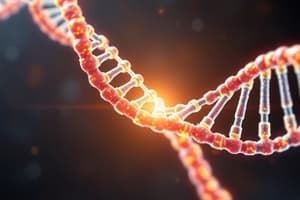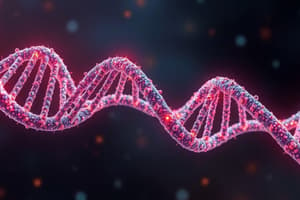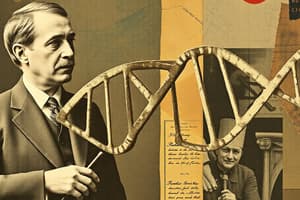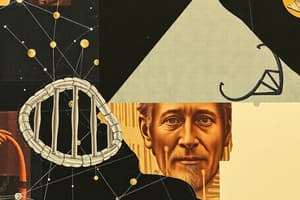Podcast
Questions and Answers
What was one of the primary focuses of Francis Crick's research after moving to the USA in 1976?
What was one of the primary focuses of Francis Crick's research after moving to the USA in 1976?
- Acoustic engineering
- Human consciousness (correct)
- Quantum mechanics
- Protein synthesis
Which significant scientific publication featured Crick and Watson's work on DNA?
Which significant scientific publication featured Crick and Watson's work on DNA?
- Nature (correct)
- Science
- Physical Review
- Cell
What was Francis Crick's educational background before his career in biology?
What was Francis Crick's educational background before his career in biology?
- Chemistry
- Engineering
- Physics (correct)
- Mathematics
In which year did Francis Crick complete his PhD?
In which year did Francis Crick complete his PhD?
Which organization awarded Francis Crick a Nobel Prize in 1962?
Which organization awarded Francis Crick a Nobel Prize in 1962?
What was one of James Watson's significant contributions to biological research?
What was one of James Watson's significant contributions to biological research?
At what age did James Watson begin his university education?
At what age did James Watson begin his university education?
Which prestigious project did James Watson lead in 1989?
Which prestigious project did James Watson lead in 1989?
Where did Watson conduct significant research before returning to Cambridge?
Where did Watson conduct significant research before returning to Cambridge?
In which year did Watson become a professor of biology at Harvard?
In which year did Watson become a professor of biology at Harvard?
What were the main components of DNA identified by scientists?
What were the main components of DNA identified by scientists?
Which scientist's data significantly aided Crick and Watson in their discovery of DNA's structure?
Which scientist's data significantly aided Crick and Watson in their discovery of DNA's structure?
What was the unique approach Crick and Watson used to determine the DNA structure?
What was the unique approach Crick and Watson used to determine the DNA structure?
What significant accomplishment occurred in 1953 regarding DNA research?
What significant accomplishment occurred in 1953 regarding DNA research?
Which of the following statements is true about Oswald Avery's 1944 discovery?
Which of the following statements is true about Oswald Avery's 1944 discovery?
How long did it take Crick and Watson to develop their final DNA model once they had all the necessary information?
How long did it take Crick and Watson to develop their final DNA model once they had all the necessary information?
What was one of the significant consequences of the discovery of DNA's structure?
What was one of the significant consequences of the discovery of DNA's structure?
Which statement correctly describes the nature of the collaboration between Crick and Watson?
Which statement correctly describes the nature of the collaboration between Crick and Watson?
What was the primary contribution of Franklin to the discovery of DNA's structure?
What was the primary contribution of Franklin to the discovery of DNA's structure?
Which of the following statements about the pairing of DNA bases is correct?
Which of the following statements about the pairing of DNA bases is correct?
What was a consequence of Wilkins' actions concerning Franklin's data?
What was a consequence of Wilkins' actions concerning Franklin's data?
Which feature distinguishes the structure of DNA described as resembling a twisted ladder?
Which feature distinguishes the structure of DNA described as resembling a twisted ladder?
In which year did Watson and Crick complete their DNA model?
In which year did Watson and Crick complete their DNA model?
What was one of the main scientific impacts of Watson and Crick's discovery of DNA?
What was one of the main scientific impacts of Watson and Crick's discovery of DNA?
Which of the following statements accurately reflects the recognition of Franklin's contribution?
Which of the following statements accurately reflects the recognition of Franklin's contribution?
What materials did Watson and Crick use to create their 3D model of DNA?
What materials did Watson and Crick use to create their 3D model of DNA?
Flashcards
X-ray Diffraction
X-ray Diffraction
The process of determining the structure of a molecule using X-ray diffraction. This technique involves shining X-rays at a crystal and analyzing the pattern of diffracted beams to infer the arrangement of atoms within the molecule.
Who was Francis Crick?
Who was Francis Crick?
Francis Crick was a British biophysicist who made groundbreaking contributions to molecular biology, notably the discovery of the structure of DNA, deciphering the genetic code, and research on the brain and consciousness.
What is the structure of DNA?
What is the structure of DNA?
The double helix structure of DNA, where two strands of nucleotides are twisted around each other like a ladder, with the bases pairing up in a specific way.
What is the genetic code?
What is the genetic code?
Signup and view all the flashcards
What is neurobiology?
What is neurobiology?
Signup and view all the flashcards
Who is James Watson?
Who is James Watson?
Signup and view all the flashcards
What did Watson study in his early education?
What did Watson study in his early education?
Signup and view all the flashcards
Who did Watson collaborate with for the DNA discovery?
Who did Watson collaborate with for the DNA discovery?
Signup and view all the flashcards
What prestigious award did Watson receive for his work on DNA?
What prestigious award did Watson receive for his work on DNA?
Signup and view all the flashcards
What other important projects did Watson contribute to?
What other important projects did Watson contribute to?
Signup and view all the flashcards
DNA Replication
DNA Replication
Signup and view all the flashcards
Nucleotides
Nucleotides
Signup and view all the flashcards
Base Pairing
Base Pairing
Signup and view all the flashcards
Crick & Watson's Discovery
Crick & Watson's Discovery
Signup and view all the flashcards
What is DNA?
What is DNA?
Signup and view all the flashcards
Genetic Code
Genetic Code
Signup and view all the flashcards
Transcription
Transcription
Signup and view all the flashcards
Translation
Translation
Signup and view all the flashcards
What is the shape of DNA?
What is the shape of DNA?
Signup and view all the flashcards
What makes up the sides of the DNA ladder?
What makes up the sides of the DNA ladder?
Signup and view all the flashcards
What makes up the rungs of the DNA ladder?
What makes up the rungs of the DNA ladder?
Signup and view all the flashcards
What are the base pairing rules in DNA?
What are the base pairing rules in DNA?
Signup and view all the flashcards
What did Chargaff's rules state?
What did Chargaff's rules state?
Signup and view all the flashcards
What was the significance of the discovery of DNA's structure?
What was the significance of the discovery of DNA's structure?
Signup and view all the flashcards
How did the discovery of DNA's structure impact our understanding of inheritance?
How did the discovery of DNA's structure impact our understanding of inheritance?
Signup and view all the flashcards
Who won a Nobel Prize for the discovery of DNA's structure?
Who won a Nobel Prize for the discovery of DNA's structure?
Signup and view all the flashcards





